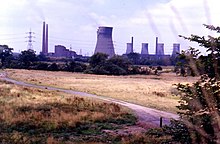Hams Hall power stations
| Hams Hall Power Station | |
|---|---|

Hams Hall B and C power stations
Viewed from the east in August 1984 |
|
| Country | England |
| Location | Warwickshire, West Midlands |
| Coordinates | 52°31′29″N 1°42′19″W / 52.524608°N 1.705175°WCoordinates: 52°31′29″N 1°42′19″W / 52.524608°N 1.705175°W |
| Commission date | 1928 |
| Decommission date | 1992 |
| Operator(s) | Central Electricity Generating Board |
| Thermal power station | |
| Primary fuel | Coal-fired |
| grid reference SP201919 | |
Hams Hall Power Station refers to a series of three, now demolished coal-fired power stations, situated in Warwickshire in the West Midlands of England, 9 miles (14 km) from Birmingham.
Following the death of Lord Norton in 1905, his estate was put up for sale in 1911. Part of the house was rebuilt near Cirencester, but the rest was demolished in 1920. Hams Hall Power Station was constructed on the site in 1928. It was opened on 6 November 1929, equipped with two Fraser & Chalmers 30,000 kW turbo-alternators. The generating capacity of the site was progressively increased to 240,000 kW. The station burned approximately 774,000 tonnes of coal a year. At the time it was one of the largest power stations in Europe.
The station was also the first power station in the United Kingdom to burn pulverised coal, rather than lumps of coal. It was also used as a prototype site for the installation of gas turbines in coal-fired plants. Water for the station was cooled by six reinforced concrete hyperbolic cooling towers. At the time, these were the largest cooling towers ever built. The station had two 350 feet (110 m) tall chimneys.
The station's closure was announced in 1975, following a fall in electricity consumption. By the time of its closure its generating capacity had fallen to 151 MW. The station's chimneys and cooling towers were demolished in 1978.
The second station on the site, Hams Hall B Power Station, was planned in 1937. It began generating electricity in 1942. The station was expanded between 1946 and 1949. The station had a generating capacity of 160,500 kW. Its water was cooled by four cooling towers. The station used Parsons turbo-alternators.
In December 1945 there was complaint about pollution from the station. This was caused by a corroded metal connection between the boilers and the chimneys. The pollution continued until 1948, when the connection was eventually replaced.
...
Wikipedia
